Mobility
| Buildings | |||||||||||
|---|---|---|---|---|---|---|---|---|---|---|---|
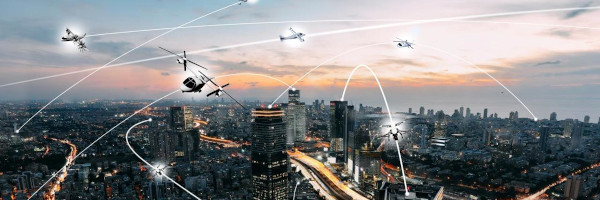
| |||||||||||
| Sectors | Buildings Transportation | ||||||||||
| Contact | Yuri Gawdiak | ||||||||||
| Topics |
| ||||||||||
Activities
| |||||||||||
- Authors
Mobility has been a constantly evolving critical feature of human civilization. Major changes and advances in mobility have been linked to the advent of new power sources (animals, wind, steam, fossil fuels, super dense batteries, etc.).
We are now in another major acceleration phase of new transportation capabilities enabled by increasingly dense, and powerful, electric based propulsion systems as well as advances in: communication, navigation, and command & control. In addition, increasingly intelligent systems are being developed and integrated creating an emerging capability of autonomous operations. National Aeronautics and Space Administration’s (NASA) Urban Air Mobility concept is an example that has been enabled by these new technology capabilities. [Figure 1.0].
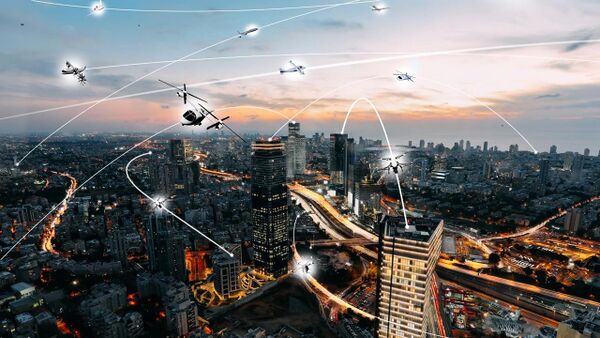
Smart Buildings will both leverage this new evolution in mobility as well as enable and enhance it by acting as key departure and destination nodes with advanced capabilities and structures.
- New Mobility Modes and Operations
New mobility modes are being driven by two relatively new vectors: increased battery power and density and autonomous systems.
- Electric Systems
Increased battery power is leading to a whole new range mobility systems that are radically resizing mobility capabilities to better fit actual passenger and cargo demand. These systems can include a range of vehicles from bikes, to scooters, to mopeds, and other unique and custom designed delivery systems [Figure 2]. This new capability is being enhanced by networked intelligent services enabling on demand capabilities: providing the right vehicle, at the right time, at the right place. This capability begins to obviate the high cost of flexibility evident in today’s automotive concepts where passenger cars[1] are designed for an average of 4-5 passengers, but are mostly occupied by 1.67 individuals[2].
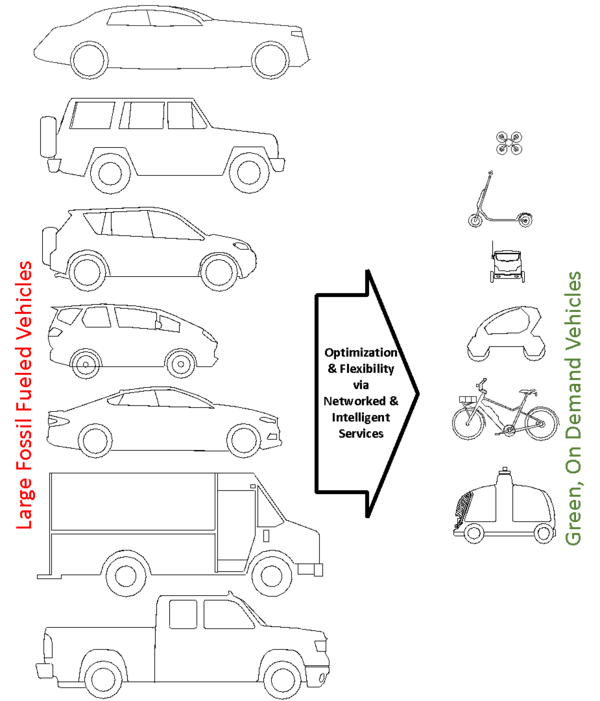
The on demand services are further enhanced by support from smart buildings with local green power generation as well adaptable and reconfigurable spaces that can support and compliment these new mobility services at key demand locations by not only providing recharging/refueling capabilities, but also safe and efficient storage and docking of the systems when not in use.
Augmenting Smart Buildings with shared, local neighborhood mobility systems can also allow deliveries to be done more efficiently. Instead of large delivery vehicles having to visit each building and block traffic, large delivery vehicles can pause at the periphery of walkable neighborhoods and zones and have shared intelligent autonomous neighborhood UAS’s and UGV’s meet them there and make the final deliveries, freeing up the large delivery vehicles from having to wait for the UAS’s & UGV’s to return. That improves the delivery speeds, reduces congestion, noise, and emissions.
These trends are emerging from various socioeconomic drivers. The COVID-19 Pandemic response in Seattle in May 2020 is an example of one such community adaptation: “Seattle to permanently close 20 miles of streets to traffic so residents can exercise and bike on them.”[3] This society’s desire to make walkable communities naturally comes with collateral benefits such as: reductions in noise, energy usage, and decreased vehicle size and weights improving safety. Another example is a 2020 campaign platform for the mayor of Paris, “Every Street in Paris to be Cycle-Friendly by 2024, Promises Mayor – Should she get reelected as Mayor of Paris, Anne Hidalgo plans to turn the French capital into a myriad of neighborhoods where ‘you can find everything you need within 15 minutes from home’.[4]”
These socioeconomic trends point to the need for smart buildings and cities to revise their architectural concepts to include more sophisticated and modern interfaces, docking, staging, and access methods for small drones, unmanned ground/air vehicles, and personal vehicle rentals, to provide local, on demand shared & public passenger/cargo capabilities. The successful implementation of more integral structural & services accommodations for smart buildings will help prevent scooters, bikes, and other systems from being carelessly left out in the streets, clogging operations, and getting prematurely damaged, but rather enable more safe & efficient building/neighborhood quality of life improvements by providing equitable and reconfigurable access and enhanced synergies for the new mobility operations & business models.
- Autonomous Systems
The more fundamental change to mobility is the planning and development of increasingly autonomous, unmanned systems. [Figure 3]. These systems are being built for an increasing number of environments, not only externally (air, marine, and surface), but also with within structures (confined spaces around buildings as well as within them such as corridors, pipes, ducts, and conduits of various kinds).
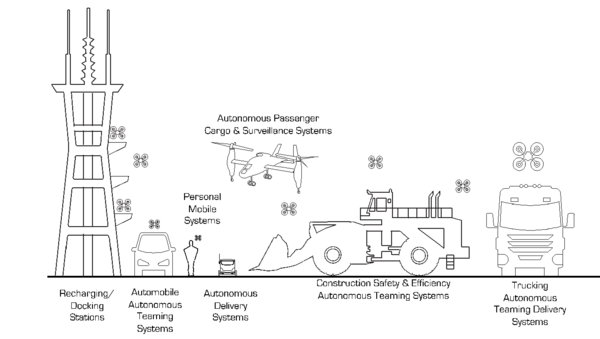
New forms of increasingly autonomous mobility systems are at various stages of maturity and deployment providing enhanced or new capabilities in:
- Automated Cargo Delivery
- Traditional: ground, air, and sea
- Last mile package delivery
- Airborne delivery to and from mobile systems
- Internal Structures: Office/Desk/Work Station package delivery
- Mobile Robotic Security & Surveillance Systems
- Mobile Robotic Inspections
- External – buildings, sites and geographic locations
- Internal (small & micro UAS)
- Pipes
- Vents
- Conduits
- Etc..
- Mobile Robotic Cleaning Systems
- Mobile Robotic Lawn Care & Landscaping
- Automated Fire Fighting & Rescue Systems
- Autonomous Site Coordination & Mobile Operations Safety Monitoring Systems
- Personal Flight Following Systems
- On Demand Mobility Services
- On Demand Autonomous Vehicle Rentals
- Autonomous Urban Air Mobility
- Others
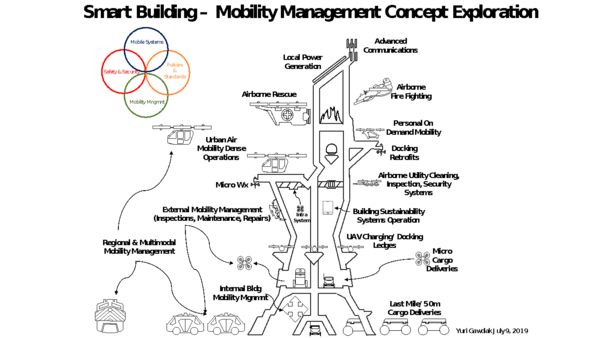
This is an unprecedent explosion of new modes of mobility [Figure 4]. The challenge to states, regions, communities and cities are immense. There is a very high risk of suboptimal designs and implementations if these changes are addressed independently and asynchronously. The Copenhagenize Index[6] has been developed to help rank the holistic aspects of cities to support bicycle-friendly transportation services. We’re recommending for the Smart Building and Transportation Superclusters to build off the Copenhagenize Index and to expand it to cover these new modes and multimodal operations to better help track and manage efforts in this critical area.
- Smart City Mesh Network
The proliferation of new modes of mobility including intelligent systems operating on, in, and around buildings will require building level traffic management capabilities merged with security and operations systems to ensure overall location safety and efficiency. [Figure 4.]. Integration of new mobility operations are a key evolving aspect of the Smart City Mesh Network, providing adaptive multimodal capabilities to best meet dynamic physical interaction demands [Figure 5].
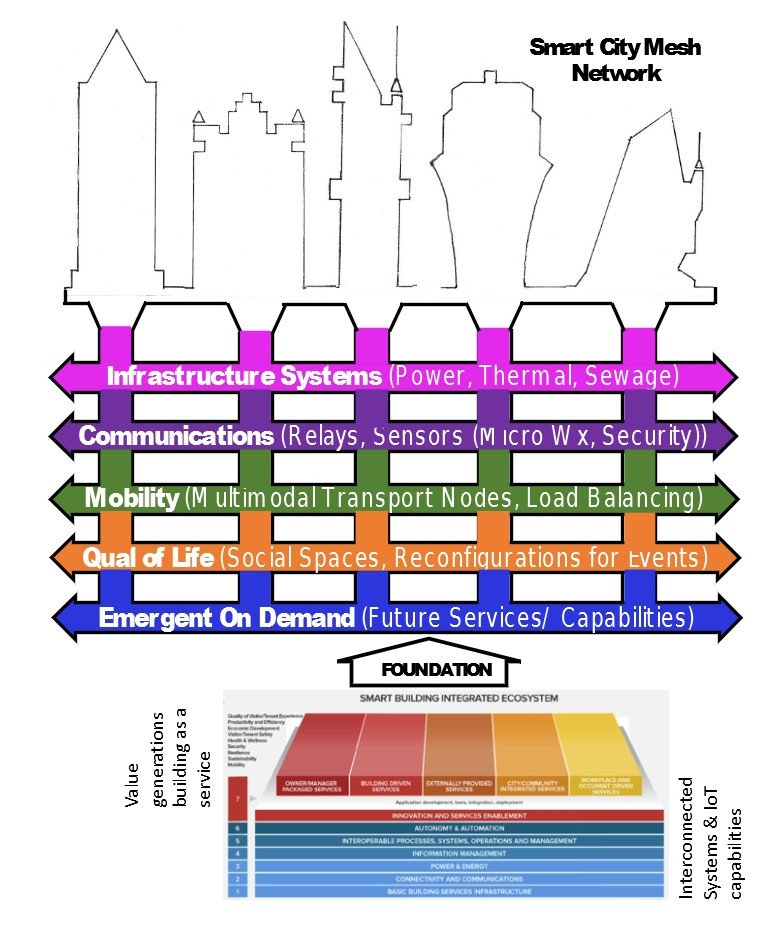
This mobility adaptability is organized around:
- Individual smart building level with reconfigurable entrances, loading zones, docking, and refueling/charging facilities for a range of vehicles;
- Block/street/pier level with coordination of sets of buildings and shared systems to adjust larger mobility events, disruptions. Examples include creating temporary landing, parking, maintenance sites or adaptable staging or recovery areas where mobile systems can meet dynamic demand;
- City level for city-wide accommodations to increase overall systems-of-systems efficiencies or adaptations to deal with emergencies and/or large-scale, unique events.
- Mobility Traffic Management Systems & Services
- Historic Traffic Management Drivers
In terms of traditional transportation, a key feature, for safety and efficiency reasons, has been the implementation of traffic management control signage and active flow control systems. Traffic management is usually located in either areas of high density or where active right of ways need to be provided. Examples of these are surface streets with traffic lights, stops signs, or buoys in harbors, or airport & ramp towers using surface markers and digital systems to control local aircraft operations and flows. Typically, where there’s low density or very complex individual operations we rely on humans to provide safe separation and integration. Examples are farms, warehouses, construction sites, open oceans, and visual flight rules with general aviation.
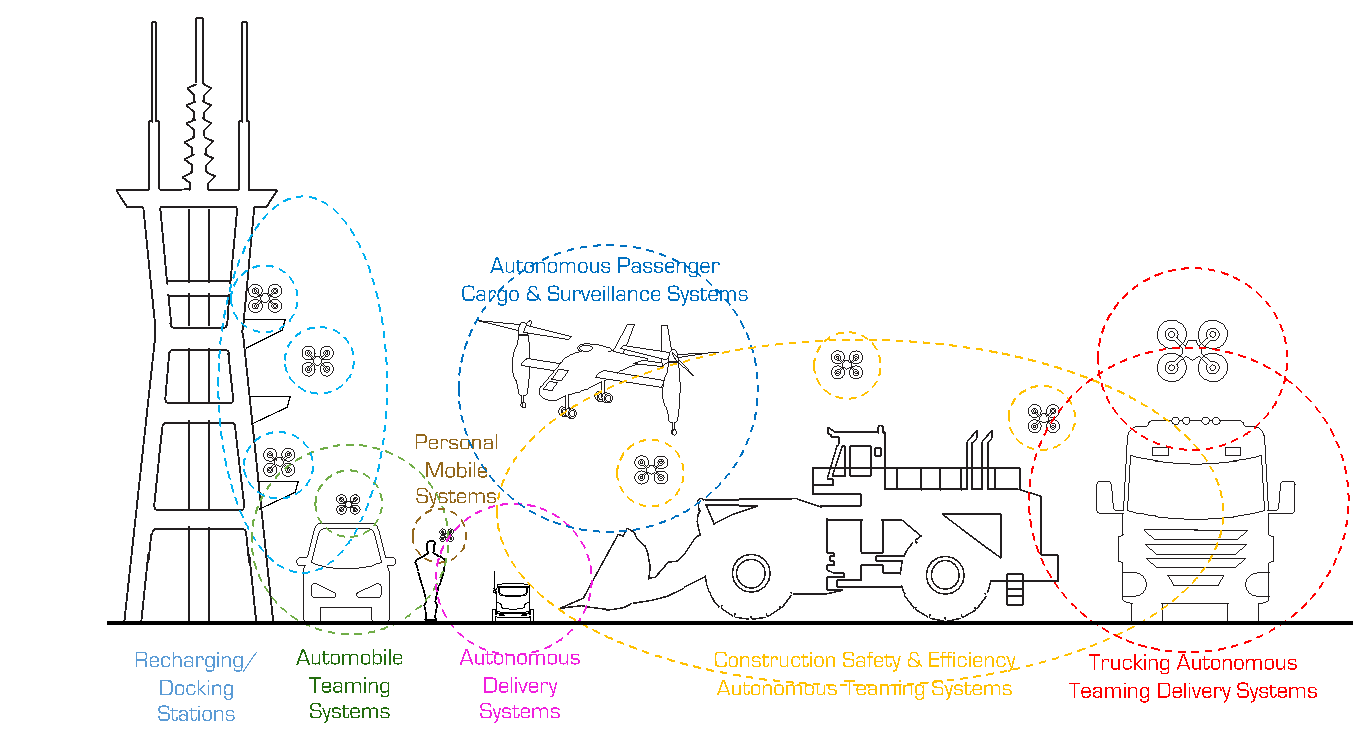
- New Mobility Management Systems
Figure 4 and Figure 6 depict the multiple layers of interactions of disparate mobility systems that will need to operate in an ever changing, overlapping, multi systems-of-systems environments. Local coordinated operations will need to be able to be spontaneously created as demand requires for occurrences with dense, multiple operators executing their responsibilities at: accident scenes, protests, social celebrations and other episodic locations and events that will require high levels of coordination and collaboration. To support these increasingly autonomous systems capabilities we’ll need a mobility traffic management systems and services will need to allow for:
- Systems to work freely, seamlessly moving from autonomous to highly coordinated mobility operations;
- Operations in dense, multi system locations with overlapping areas of control and coordination between disparate operators and missions;
- Coordinated, dynamic teaming systems in various custom configurations, swarms, and flock like assemblies;
- The ability to move in out of various environments seamlessly (inside and outside of buildings, inside and outside systems/systems-of-systems); and
- The ability to do coordinated graceful degradation for off-nominal conditions.
And as depicted in the [Figure 4.0] and [Figure 6.0] the management environments will range from micro locations: inside buildings, ducts, piping to external building operations, to coordinated block size activities, and upto: coordinated city, region, national and international operations. These operations will need to be integrated through the Smart Cities Network Mesh to provide status, configuration, and coordination information for successful, safe, and efficient mobility operations.
- Benefits
Developing smart buildings with mobility as one of the integrated design considerations brings forth a broad range of civic outcome benefits as categorized in Chapter 2 on Valuation, Benefits ad ROI Considerations.
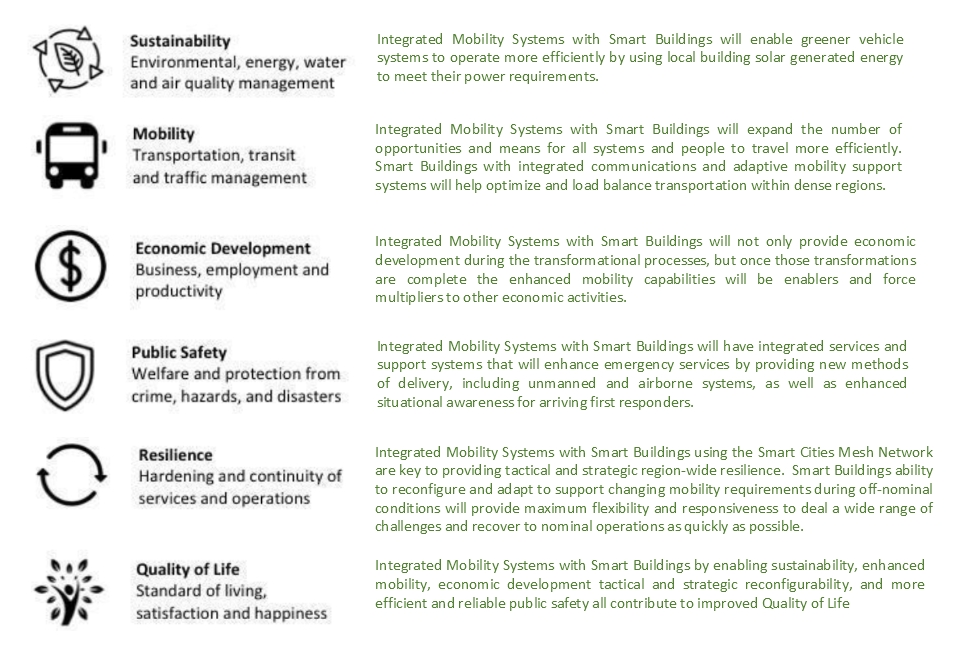
Figure 7 provides the specific benefits of integrating mobility systems with smart building architectures.
- Research Development & Integration
Smart buildings are at the nexus of these new mobility modes and operations. They are usually either the starting and/or end points of a given set of mobility operations. Given the broad scope of these interactions a private/public partnership is the ideal way to develop standards, identify technology challenges and work the various policy and guidelines needed to help insure a smooth, safe, and efficient evolution of new mobility capabilities integrated with smart buildings.
It is recommended that several federal agencies and communities of practice coordinate their activities in this area to maximize society’s investments in these areas. Below is an initial, but by no means exhaustive list of initiatives and organizations that would benefit from strategic collaboration on mobility operations for smart buildings:
- Global Cities Teams Challenge (GCTC)
- GCTC Transportation SuperCluster (TSC) & Blueprint
- GCTC Wireless SuperCluster (WSC) & Blueprint
- Networking and Information Technology Research & Development Program
- Computing-Enable Networked Physical Systems (CNPS)
- Intelligent Robotics and Autonomous Systems (IRAS)
- Department of Transportation (DoT) Intelligent Transportation Systems (ITS)
- U.S. Department of Commerce, National Telecommunications and Information Administration
- NASA Urban Air Mobility (UAM) Ecospheres Working Groups
- Association for Unmanned Vehicle Systems International (AUVSI)
- Others
- Conclusion
The evolution of transportation and the current rapid increase of new modes of mobility is symbiotic with new thinking of the design and build of the built environment (municipalities and buildings) – trends in each affects the other in the mutual transformation and adjustment to new requirements and new opportunities for the built environment. For example, zero carbon emissions goals are affecting changes in private car usage within a city, which in turn is affecting design of buildings to more easily accommodate ride share and electric power.
The benefits of integrating new mobility modes with smart buildings have many synergistic benefits that can be most rapidly accomplished through private/public partnerships maximizing the innovative aspects of industry with federal, state, and local standards, policies and guidelines efforts. Those efforts coupled with, and informing federal and state infrastructure initiatives as well as government research and development investments will help enrich our smart cities & communities making them better prepared to take on the challenges and opportunities of the future.
- ↑ Crossover utility vehicles have become the most popular light-duty vehicle type. Their increased robustness and flexibility comes at the cost of decreased fuel efficiency over regular passenger vehicles.
- ↑ 2017 National Household Travel Survey by the Federal Highway Administration (FHWA)
- ↑ Seattle to permanently close 20 miles of streets to traffic so residents can exercise and bike on them
- ↑ Every Street In Paris To Be Cycle-Friendly By 2024, Promises Mayor
- ↑ Concept developed at the 2018 Global Cities Team Challenges Conference, Washington, D.C.
- ↑ Copenhagenize Design Co.



